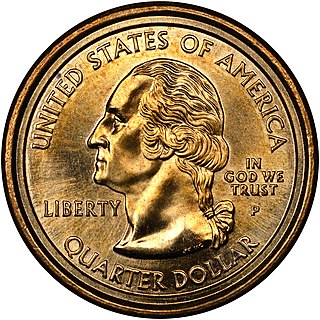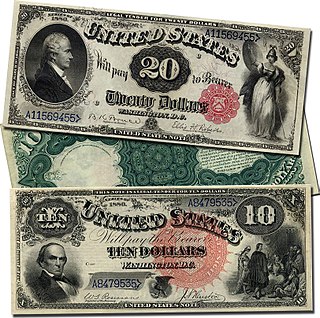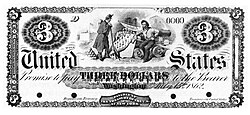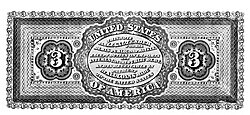
The United States one-cent coin, often called the penny, is a unit of currency equaling one one-hundredth of a United States dollar. The cent's symbol is ¢. The first U.S. cent was produced in 1787, and the cent has been issued primarily as a copper or copper-plated coin throughout its history. Its obverse has featured the profile of President Abraham Lincoln since 1909, the centennial of his birth. From 1959 to 2008, the reverse featured the Lincoln Memorial. Four different reverse designs in 2009 honored Lincoln's 200th birthday and a new, "permanent" reverse – the Union Shield – was introduced in 2010. The coin is 0.75 inches (19.05 mm) in diameter and 0.0598 inches (1.52 mm) in thickness. Its weight has varied, depending upon the composition of metals used in its production.

1943 steel cents are U.S. one-cent coins that were struck in steel due to wartime shortages of copper. The Philadelphia, Denver, and San Francisco mints each produced these 1943 Lincoln cents. The unique composition of the coin has led to various nicknames, such as wartime cent, steel war penny, and steelie. The 1943 steel cent features the same Victor David Brenner design for the Lincoln cent which had been in use since the first in 1909.

The United States Mint has minted numerous commemorative coins to commemorate persons, places, events, and institutions since 1848. Many of these coins are not intended for general circulation, but are still legal tender. The mint also produced commemorative medals, which are similar to coins but do not have a face value, and therefore are not legal tender.

The 1955 doubled die cent is a die variety that occurred during production of the one cent coin at the United States Mint in 1955.

The Canadian five-cent coin, commonly called a nickel, is a coin worth five cents or one-twentieth of a Canadian dollar. It was patterned on the corresponding coin in the neighbouring United States. It became the smallest-valued coin in the currency upon the discontinuation of the penny in 2013. Due to inflation, the purchasing power of the nickel continues to drop and currently the coin represents less than 0.5% of the country's lowest minimum hourly wage.
Below are the mintage figures for the United States cent.

The United States large cent was a coin with a face value of 1/100 of a United States dollar. Its nominal diameter was 11⁄8 inch (28.57 mm). The first official mintage of the large cent was in 1793, and its production continued until 1857, when it was officially replaced by the modern-size one-cent coin.

The Flying Eagle cent is a one-cent piece struck by the Mint of the United States as a pattern coin in 1856 and for circulation in 1857 and 1858. The coin was designed by Mint Chief Engraver James B. Longacre, with the eagle in flight based on the work of Longacre's predecessor, Christian Gobrecht.
The silver center cent is an American pattern coin, one of the precursors to the large cent and an early example of a bimetallic coin. Less than a dozen specimens are known to exist today, and they generally fetch substantial prices; an uncirculated silver center cent sold at auction for $414,000 in January 2002. That price was eclipsed by an example graded PCGS MS61 offered at auction in April 2012, with a price tag of more than $1 million.

The 1974 aluminum cent was a one-cent coin proposed by the United States Mint in 1973. It was composed of an alloy of aluminum and trace metals, and intended to replace the predominantly copper–zinc cent due to the rising costs of coin production in the traditional bronze alloy. Of the 1,571,167 coins struck in anticipation of release, none were released into circulation. To encourage congressional support for the new alloy, the Mint distributed several examples to US Congressmen. When the proposed aluminum cent was rejected, the Mint recalled and destroyed those coins. However, despite the recall, a few aluminum cents were not returned to the Mint, and those coins may remain at-large. One example was donated to the Smithsonian Institution, while another was alleged to have been found by a US Capitol Police Officer. A 1974-D specimen was found in January 2014 by Randall Lawrence, who said it was a retirement gift to his father, who worked at the Mint in Denver. Randall planned on selling it in a public auction, but the Mint demanded its return, saying that the coin was never authorized for release and therefore remains U.S. Government property. Lawrence ultimately surrendered the coin when the Mint showed that the aluminum cent had never been authorized to be struck in Denver, and there was no evidence that the coin had been a gift of any kind.

The Half union was a United States coin minted as a pattern, or a coin not approved for release, with a face value of fifty U.S. Dollars. It is often thought of as one of the most significant and well-known patterns in the history of the U.S. Mint. The basic design, featuring Liberty on the obverse, was slightly modified from the similar $20 "Liberty Head" Double Eagle, which was designed by James B. Longacre and minted from 1849 to 1907.

The Coronet large cent was a type of large cent issued by the United States Mint in Philadelphia from 1816 until 1839.

The two-cent billon was a pattern US coin struck in 1836 and initially proposed as part of the Act of January 13, 1837. Versions exist with either a reeded edge and coin orientation or a plain edge and medal orientation; however, those with the former tend to be original strikes, whereas the latter are always proof restrikes.

The ring cent or holey cent was a one-cent pattern coin first struck in various compositions and designs between 1850 and 1851 as part of an experiment on producing a cent with a reduced weight and diameter, as the rising price of copper had caused cents to cost more than their face value to produce. Many varieties exist, with differing designs as well as differing compositions, including billon (standard), aluminum, copper, cupronickel, nickel silver, nickel, silver, and white metal.

The Union was a proposed $100 coin of the United States dollar. It was cancelled before any pattern coins could be minted.

The 1942 experimental cents were pattern coins struck by the United States Mint to test alternative compositions for the penny.

The 2000 Sacagawea dollar – Washington quarter mule is an error coin featuring the obverse of the Washington quarter on the planchet of a Sacagawea dollar. It is the first known authentic mule coin released by the United States Mint.

The Continental Currency dollar coin was the first coin struck for the United States. The coins were minted in 1776 and were made of pewter, brass, or silver.

The Washington nickel is a pattern coin that was struck by the United States Mint in 1866 and again in 1909 and 1910.













































